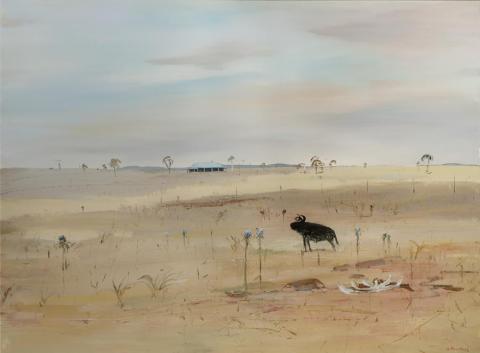WIMMERA LANDSCAPE WITH HOMESTEAD AND RAM, c.1980
Arthur Boyd
oil on canvas
90.0 x 120.5 cm
signed lower right: Arthur Boyd
inscribed verso: Woomera [sic]Landscape with House [sic]
Thos Agnew and Sons Ltd, London
(shipping label attached verso)
Martin Browne Fine Art, Sydney
Private collection, Melbourne
Private collection, Sydney
In the summer of 1948 - 49, Arthur Boyd accompanied the poet Jack Stephenson on a trip to Horsham near the border of the Wimmera River. It was there, inspired by his earlier, though far more verdant landscapes of Harkaway and Berwick, that Boyd created the first of some of his most luminous and acclaimed landscapes.
First exhibited in 1950 at the David Jones Gallery, Sydney, the Wimmera works were greeted with universal acclaim. Embedded within the palette of the Heidelberg School, the paintings resonated not only amongst the public, but also with both the National Gallery of Victoria and the Art Gallery of New South Wales who both purchased landscapes from the exhibition. Significantly, those works were the first of Boyd's to be acquired by major public galleries, and established his reputation as 'an interpreter of the rural Australian environment.'1
Boyd was to return on many occasions over the following years, bewitched by the purifying heat and scorched palette. As Barry Pearce notes, 'He discovered there the hint of something that had drawn other painters of his generation, a subject tentatively recorded by only a few artists of the nineteenth century, and touched on by even fewer in the twentieth: the empty spaces of the great interior. Of course the Wimmera was wheat country, and not by any means forbidding, nor forsaken. But in dry hot weather it could have, over sparse, unbroken horizons, a searing expanse of sky that elicited an acute sense of the infinite.'2
With its vast expanse and clarity of light, the Wimmera remained a subject that Boyd was to revisit throughout his career, resulting in a unique and defining vision of the Australian landscape.
1. Phillip, F., Arthur Boyd, Thames and Hudson, London, 1967, p. 67
2. Pearce, B., Arthur Boyd Retrospective, The Art Gallery of New South Wales and The Beagle Press, Sydney, 1993, p. 20
